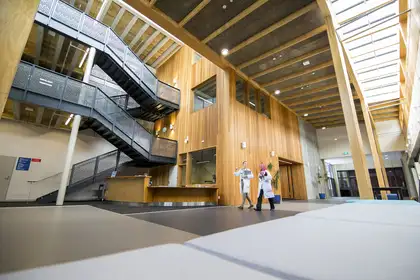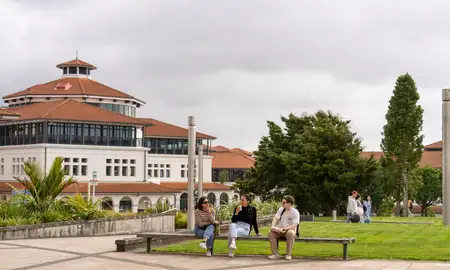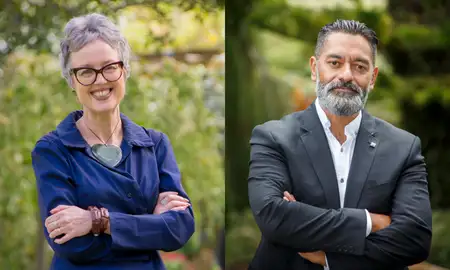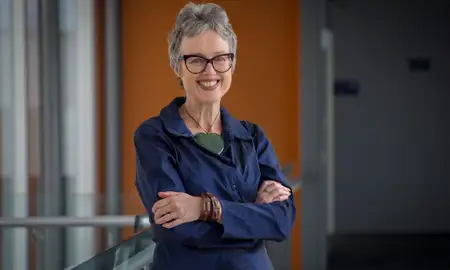
The Tāwharau Ora School of Veterinary Science building was opened in 2022, and features state of the art facilities for student learning.
This opinion piece was first published on Stuff.
There’s a revolution happening in the world of universities. Students, staff and community expectations of the role and purpose of universities have shifted dramatically in the wake of COVID-19 and – here’s the punchline – we are never returning to the way it was. This ‘quiet revolution’ is at its most palpable on our university campuses; once thriving centres of activity, many universities around the world are now struggling to get staff and students back on campus, seeking creative ways to make it ‘worth the commute’. So, what characterises a university campus in the ‘post-pandemic’ 21st century? And why do we need to change?
A 2022 Ernst & Young report, ‘Are universities of the past still the future?’, notes that while the peak of the COVID-19 emergency has passed, universities globally are still grappling with the fallout of the pandemic. And we’ve seen here in Aotearoa New Zealand how the rapid pivot to online learning was just the tip of the iceberg in terms of change. It is now clear that there will be no pendulum swing back to the way things were. This tsunami of change goes beyond the current digital disruption challenging businesses across a range of sectors. Demographic shifts, geopolitical instability, changing workplace expectations and student preferences for super-flexibility and personalised learning comprises something of a perfect storm. Universities who adapt will be the ones who survive.
These changes are physically visible on our university campuses. A combination of declining birth rates in recent decades (meaning fewer school leavers) and a government focused on vocational education means that, for domestic students, the demand for a traditional, campus-based university education will never speak to their needs and, for providers, return full-time enrolments to pre-COVID-19 levels. We need to reset our expectations and act accordingly.

Professor Giselle Byrnes.
A recent local commentator published an opinion piece on Stuff painting a picture of a university that laments this changed context and lack of campus vibrancy, but failed to explain why. As someone who also attended university in the 1980s – and who is still part of the sector – I found myself reflecting on this dissonance and the tendency to blame universities for the current predicament.
So, what is going on? Despite urban myths, universities are not moving away from science, agricultural studies, and other lab-based subjects that typically engender an ‘engine room’ atmosphere on campus. Here at Massey, for instance, we have around 1000 doctoral students; over half are enrolled on the Palmerston North campus, more than 30 per cent on our Auckland campus and the remainder on our Wellington city campus. Each campus has active lab programmes – not just traditional science labs, but also psychology, design, and arts labs. We also have ‘distance labs’ in areas such as education where our highly talented and creative teachers are leveraging new technologies to create virtual communities of practice.
At Massey, our largest cohort is still in the sciences, which supports more than 40 per cent of doctoral students – and our largest area of doctoral research is in a key strategic strength of Massey’s, food and food-related technology, followed by agriculture and environment. These students are not just working on our campuses, but also on our farms and out in the field with partners in a range of contexts, reflecting again just how doctoral research has shifted since the 1980s.
It’s also worth highlighting that just under half of Massey’s doctoral students are international students. These students are issued visas based on their campus-based research. They cannot work at distance and many are enrolled in sciences. So much, then, for the assumption that doctoral research today largely involves historical or socio-cultural topics that don’t include empirical data collection.
While the shifts I allude to above regarding the changing nature of university campus life are driven in part by funding imperatives towards more industry aligned research, they also reflect the current desire for all things digital. Just as digital platforms and generative artificial intelligence (AI) nudges our preferences with shopping, banking, travel and a range of other services, so too for education. In short, digital disruption, accelerated by the advent of generative AI, is driving the emergence of new ecosystems for learning and knowledge creation — and setting the stage for immense innovation.
As the Ernst & Young report notes, universities are now but one category amid a range of knowledge services providers accessed through digital platforms; and in this competitive market, private providers can dramatically reduce the marginal costs of delivering, while at the same time moving to massive scale and reach. Universities no longer have a monopoly on higher learning, as global EdTech providers can now bring quality course content, underpinned by engaging video, graphics and gamified learning approaches to reimagine learning in ways that were unimaginable 30 or 40 years ago.
Having been to university in the halcyon days of the 1980s, I’m the first to admit that campus-based university education, especially for school leavers, has always been life-changing, and even a rite of passage. However, not all students need or want this from their university experience.
But, as the Ernst & Young report says, unless they reinvent themselves, universities in 2030 risk being like public libraries in 2021: temples of knowledge that few visit because information and services have been dematerialised to screens.
Universities have an enduring purpose in and for society; they have and always will continue to drive change and transformations through teaching and research. So while our contemporary context might change, our fundamental purpose continues. Let’s not get caught up in wistful thinking for a world that will not come again and perhaps, never really was.
Professor Giselle Byrnes is Provost at Te Kunenga ki Pūrehuroa Massey University.
Related news
Opinion: Meeting the ever-changing needs of Aotearoa New Zealand
By Dr Tere McGonagle-Daly

Opinion: Turning the tide for our Pacific learners
By Professor Giselle Byrnes and Professor Palatasa Havea

Opinion: Putting us on the right side of history
By Provost Professor Giselle Byrnes and Deputy Vice-Chancellor Māori Professor Meihana Durie.

Opinion: Why universities can be just as good (and cost just as much) online
Online and blended learning could be the future for universities but that doesn't mean it's cheaper to deliver, writes Massey University Provost Professor Giselle Byrnes.
